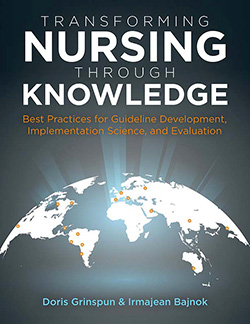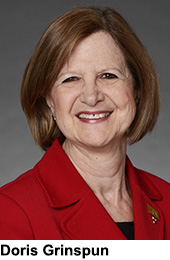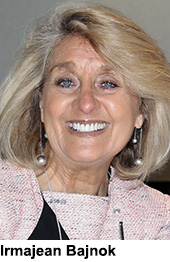Doris Grinspun and Irmajean Bajnok, coauthors of Transforming Nursing Through Knowledge, respond to questions from the editor of Reflections on Nursing Leadership (RNL).
RNL:
 In the foreword to your book, Bernadette Mazurek Melnyk, PhD, RN, CRNP, FAANP, FAAN, observes, “Although a wealth of studies document the positive outcomes associated with evidence-based care, translation of evidence into clinical practice still occurs at a snail’s pace because of multiple barriers that continue to exist in healthcare systems throughout the world.” She says your book offers a solution to that problem. How does Transforming Nursing Through Knowledge expedite the process of implementing research findings into care-benefiting practice? Is there something about your approach that makes it more effective than others?
In the foreword to your book, Bernadette Mazurek Melnyk, PhD, RN, CRNP, FAANP, FAAN, observes, “Although a wealth of studies document the positive outcomes associated with evidence-based care, translation of evidence into clinical practice still occurs at a snail’s pace because of multiple barriers that continue to exist in healthcare systems throughout the world.” She says your book offers a solution to that problem. How does Transforming Nursing Through Knowledge expedite the process of implementing research findings into care-benefiting practice? Is there something about your approach that makes it more effective than others?
Doris Grinspun and Irmajean Bajnok:
 Our book is based on a comprehensive 20-year program that teaches nurses and others how to develop evidence-based guidelines, ensure their robust uptake and sustainability, and evaluate their impact on nursing practice and outcomes for patients, organizations, and health systems. This holistic perspective inspired us to include in the book the theoretical and programmatic underpinnings for each of these three pillars of the program, as well as practical tools to ensure knowledge translation in the day-to-day education of nursing students and the clinical practice of nurses.
Our book is based on a comprehensive 20-year program that teaches nurses and others how to develop evidence-based guidelines, ensure their robust uptake and sustainability, and evaluate their impact on nursing practice and outcomes for patients, organizations, and health systems. This holistic perspective inspired us to include in the book the theoretical and programmatic underpinnings for each of these three pillars of the program, as well as practical tools to ensure knowledge translation in the day-to-day education of nursing students and the clinical practice of nurses.
 A critical aspect of our approach that is different from others and makes it more effective is the way we teach knowledge transfer. We use the latest in implementation science combined with social movement thinking. These strategies are quite different from the norm as they encompass teaching about the guideline and also how to best engage nurses and all stakeholders—at intellectual and emotional levels—to optimize evidence-based practice (EBP). Concepts such as scaling up, out, and deep; diffusing innovation; creating collective identity; and ensuring full engagement are well-explained in chapters that address both theory and practice.
A critical aspect of our approach that is different from others and makes it more effective is the way we teach knowledge transfer. We use the latest in implementation science combined with social movement thinking. These strategies are quite different from the norm as they encompass teaching about the guideline and also how to best engage nurses and all stakeholders—at intellectual and emotional levels—to optimize evidence-based practice (EBP). Concepts such as scaling up, out, and deep; diffusing innovation; creating collective identity; and ensuring full engagement are well-explained in chapters that address both theory and practice.
Pearls of wisdom are found in the many chapters where contributors from healthcare organizations, teams, and academic settings share how they systematically and successfully implemented evidence-based guidelines and changed practice in sustained ways that produced incredible outcomes. These “lived experience” chapters are a unique feature of our book, and the examples shared—which span a variety of sectors (including academia), countries, and cultures—illustrate the “how tos” of clinical guideline implementation on a variety of topics.
The final chapters of the book, which address evaluation and policy, provide tools to measure the impact of evidence-based practice and a framework for determining how best to expand EBP into policy. Thus, the book provides a full package to help individuals and organizations move evidence-based practice into the real worlds of teaching and learning, practice and administration, and policy.
RNL:
Your book, which facilitates implementation of evidence-based practice, is based on guidelines produced by the Registered Nurses’ Association of Ontario [Canada]. How did RNAO become involved in developing the guidelines, and how have the guidelines come to occupy, as you describe in the book’s introduction, a “central position in international nursing and health services”? What is there about the guidelines’ principles and usage that contributes so effectively to their international applicability?
Grinspun and Bajnok:
For a healthcare innovation to “go global,” nurses, organizations, and systems have to recognize its relevance and benefit for their own organization and country and know they will have the support needed to make it a success story for their patients. That is the case with RNAO’s Best Practice Guidelines (BPG) program and its Best Practice Spotlight Organization (BPSO) designation. To top it off, the program, with all its components, is provided free of charge. Yes, that is right. The BPGs, the full implementation support, the tools for evaluation, and even how to apply this to policy, are all provided by RNAO at no cost. Details of this are discussed in Chapter 12, which focuses on global spread.
We went global because we were approached by the government of Spain, which had learned of the wild success of the BPSO designation in Canada. Then other countries and governments got hold of it and contacted us. This local and global exposure prompted us to develop the expertise needed to respond to contextual aspects of healthcare in various countries, and this is an added benefit for organizations. We work with our BPSOs to support relevant modifications while keeping an eye on ensuring program fidelity. RNAO’s deliberate and genuine attention to theories of diffusion, social movement thinking, and change theory—together with support from peers—created the seeds of the movement that galvanized across countries and mushroomed from there.
RNL:
Both of you have written portions of Transforming Nursing Through Knowledge. There are also, by my count, 59 contributing authors. What role do they play in the book?
Grinspun and Bajnok:
We were thrilled with the response of our BPSO and other author teams. These amazing authors are critical to the book’s richness and usefulness. They all add incredible value and credibility to RNAO’s EBP success, and the book gives them the opportunity to shine as EBP leaders in their organizations and countries. Their chapters add to the understanding that EBP, when enabled through a systematic implementation process, is possible and worth pursuing.
Nurses in all roles, other healthcare professionals, policymakers, evaluators, and, of course, students will find these authors’ contributions incredibly enlightening and inspiring. The authors— who span six countries and all sectors, including academia—convey in practical detail how they made guideline implementation, practice change, and sustained engagement actually happen in their context. They address the successes as well as the challenges. Brutally honest, their contribution is key to successful implementation, evaluation, and sustained use of evidence in practice and education by other organizations and teams.
RNL:
In Chapter 1, you introduce readers to scaling up, scaling out, and scaling deep, concepts that are developed further in later chapters. For readers of Reflections on Nursing Leadership, please provide a brief explanation of those concepts.
Grinspun and Bajnok:
The concept of scaling is critical to creating, spreading, and sustaining change both locally and globally. Scaling up and scaling out, especially, are largely used in the implementation science literature and in large-scale health programs. Scaling up relates to the dissemination and uptake of a change—in our case, best practice guidelines—within an organization. The intent is to increase volume and accessibility to the innovation. For us, it means more nurses, more units, and teams in an organization. Scaling out is about expanding the reach of the innovation by spreading it outside an organization to others, either locally or globally.
Scaling deep engages participants at personal, emotional, and values levels so that the change becomes part of their value sets and the norms of the setting. Scaling deep, led by staff members, really impacts organizational culture. Although scaling deep happens only at the individual level, the strength of RNAO’s BPSOs is that scaling deep also affects organizational and health systems levels, both locally and globally. When scaling deep takes hold in such a profound way, we see the desired change embedded in how we think and act. We also see it reflected in policies, standards, and laws—in organizations as well as in governments—thus securing a permanent framework, structures, and infrastructure that sustain change.
The approaches we use enable the three types of scaling, which is demonstrated in the program’s sustained global movement and its collective identity. While scaling is a key concept evident throughout the book, Chapters 1, 10, and 11, in particular, address it. In Chapter 1, we describe the concepts. In Chapter 10, they are applied to implementation of specific best practices, and in Chapter 11, we demonstrate their use in increasing coverage and accessibility of the BPSO designation in the context of long-term care.
RNL:
In Chapter 5, you showcase technology resources developed by RNAO that play a significant role in making the program so effective. What are some of those tools, and why are they so important to the program?
Grinspun and Bajnok:
We see technology as an enabler of active and sustained use of BPGs—in all contexts. With the advent of the electronic medical record (EMR), we can now embed within that technology evidence-based tools to better support clinical decision-making, client assessment, and implementation of evidence-based interventions and their evaluation. Keeping these goals in mind, we developed very specific, BPG-related interventions titled “nursing order sets.” Working with the International Council of Nurses and using its standardized nursing coding system, known as the International Classification for Nursing Practice (ICNP), we created universal codes for these interventions.
With these coded interventions embedded in the EMR, we are able to track nursing actions and outcomes globally. These tools provide nurses and others with evidence-based interventions at their fingertips. For this unique contribution, RNAO was officially accredited as an ICNP Research and Development Centre in 2013, making it the 10th in the world and the first in North America.
We did not stop there. We also linked the order sets embedded in the EMR to the evaluation system known as NQuIRE (Nursing Quality Indicators for Recording and Evaluation). This interface enables effective and efficient evaluation of care and tracks its impact in real time. Such formal electronic documentation of nursing work provides clear evidence of nursing’s contribution to healthcare while aiding in knowledge development and evaluation. This groundbreaking approach to linking EBP and technology is expanded upon in Chapter 5 and eloquently conveyed with examples in home healthcare, acute hospital care, and long-term care. The same chapter reviews RNAO’s contribution to the spread of eHealth through its development of a specific system-related BPG—“Adopting eHealth Solutions: Implementation Strategies”—that supports overall uptake of technology in healthcare.
RNL:
In my questions, I have just scratched the surface of what is in the book. What else would you like to call attention to about the book and its benefits, or perhaps something you want to add regarding implementation of research-based evidence in patient care?
Grinspun and Bajnok:
It is very important to recognize how hard it is to initiate and sustain innovation in our extremely busy, diverse, and intense healthcare settings. Organizations that take on substantive quality improvement programs are to be commended. It is not surprising that, up until now, this has happened at a snail’s pace. Organizations are challenged, knowing that it takes 12 to 17 years to reflect new evidence in practice. With our program, it can happen in three years.
Implementing evidence-based practice at individual, organizational, and national levels is a worthy quality-improvement goal that must be pursued. RNAO’s work, as documented in this book, has fired up the EBP movement in healthcare in ways not seen before. As this book proves, it can be done, and it’s worth it—for patients, organizations, and staff. RNL
Doris Grinspun, PhD, RN, LLD (hon), Dr (hc), O.ONT, is chief executive officer of the Registered Nurses’ Association of Ontario (RNAO) and adjunct professor at various universities. Irmajean Bajnok, PhD, RN, former director of RNAO’s International Affairs and Best Practice Guidelines Centre, is adjunct professor, University of Ottawa School of Nursing.
See Chapter 6 from Transforming Nursing Through Knowledge, recently published in RNL.
Click here to purchase Transforming Nursing Through Knowledge.